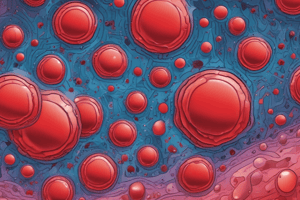Podcast
Questions and Answers
What percentage of blood is composed of plasma?
What percentage of blood is composed of plasma?
- 75%
- 45%
- 65%
- 55% (correct)
Which of the following is the primary function of erythrocytes?
Which of the following is the primary function of erythrocytes?
- Carry oxygen and carbon dioxide (correct)
- Transport vitamins to the tissues
- Regulate body temperature
- Provide immune response
What is the main role of white blood cells in the blood?
What is the main role of white blood cells in the blood?
- Maintain osmotic pressure
- Transport oxygen and nutrients
- Facilitate immune responses (correct)
- Assist in blood clotting
Which component of blood is primarily responsible for maintaining osmotic pressure?
Which component of blood is primarily responsible for maintaining osmotic pressure?
Which of the following is NOT a formed element of blood?
Which of the following is NOT a formed element of blood?
What is the primary difference between plasma and serum?
What is the primary difference between plasma and serum?
Which ion is present in the highest concentration in plasma?
Which ion is present in the highest concentration in plasma?
A deficiency in red blood cells is referred to as?
A deficiency in red blood cells is referred to as?
What is the primary function of red blood cells?
What is the primary function of red blood cells?
Which of the following white blood cells is primarily involved in fighting bacterial infections?
Which of the following white blood cells is primarily involved in fighting bacterial infections?
What is the main difference between plasma and serum?
What is the main difference between plasma and serum?
What percentage of the total leukocyte count do lymphocytes represent?
What percentage of the total leukocyte count do lymphocytes represent?
Which function of blood is primarily responsible for transporting nutrients to tissues?
Which function of blood is primarily responsible for transporting nutrients to tissues?
In normal conditions, what is the average platelet count per cubic millimeter of blood?
In normal conditions, what is the average platelet count per cubic millimeter of blood?
Which type of leukocyte primarily combats parasitic infections?
Which type of leukocyte primarily combats parasitic infections?
What role does blood play in the regulation of body temperature?
What role does blood play in the regulation of body temperature?
What is the primary function of red blood cells in the body?
What is the primary function of red blood cells in the body?
Which component of blood constitutes approximately 55% of its total volume?
Which component of blood constitutes approximately 55% of its total volume?
What is the main difference between plasma and serum?
What is the main difference between plasma and serum?
Which type of blood cell is primarily responsible for immune responses and fighting infections?
Which type of blood cell is primarily responsible for immune responses and fighting infections?
What is the typical normal range for hematocrit in adults?
What is the typical normal range for hematocrit in adults?
From what type of cell do all blood cells originate?
From what type of cell do all blood cells originate?
Study Notes
Blood Composition
- Blood comprises plasma (55%) and formed elements (45%).
- Plasma primarily consists of water (91%); solids make up 9%, including proteins, enzymes, lipids, glucose, amino acids, fatty acids, electrolytes, hormones, vitamins, and metabolic waste.
- Key plasma proteins account for 7% of total plasma volume; important for osmolarity.
- Major inorganic molecules in plasma include sodium, chloride, bicarbonate, potassium, and calcium.
Hematology
- Erythrocytes (red blood cells) transport oxygen to tissues and return carbon dioxide to the lungs.
- A deficiency in red blood cells leads to anemia.
- Blood forms in red bone marrow from stem cells, maturing into RBCs, WBCs, and platelets.
- Typical total RBC count ranges from 4.5 to 5.5 million cells per cubic millimeter.
White Blood Cells (Leukocytes)
- White blood cells are crucial for the immune response, reacting to infections and foreign invaders.
- Types of leukocytes include granulocytes (neutrophils, eosinophils, basophils) and agranulocytes (lymphocytes, monocytes).
- Normal total leukocyte count ranges from 4,000 to 11,000 cells per cubic millimeter.
Plasma vs. Serum
- Serum is the fluid that separates from blood when it clots; it lacks clotting factors such as fibrinogen and prothrombin.
- Plasma contains the clotting factors and is slightly more complex than serum.
Functions of Blood
- Respiratory: Transport oxygen from lungs to tissues and carbon dioxide from tissues to lungs.
- Nutritive: Deliver nutrients to tissues.
- Excretory: Carry metabolic waste to elimination sites (kidneys, skin, lungs).
- Transport: Distribute hormones, vitamins, and enzymes throughout the body.
- Storage: Serve as a reserve for water and electrolytes, including glucose and sodium.
- Regulation: Help maintain body temperature through high specific heat and conductivity.
Blood Parameters
- Platelet count typically ranges from 150,000 to 400,000 cells per cubic millimeter.
- Blood urea nitrogen (BUN) levels range from 10 to 20 mg/dL, while glucose levels are usually between 3.4 and 5.6 mmol/L (60-100 mg/dL).
- Significant electrolytic concentrations include sodium (150 mmol/L) and potassium (3.5-5.0 mmol/L).
Blood Circulation
- Arteries transport oxygen-rich blood from the heart; they taper into capillaries for nutrient exchange with tissues.
- Capillaries connect to veins, which return deoxygenated blood to the heart.
Studying That Suits You
Use AI to generate personalized quizzes and flashcards to suit your learning preferences.
Related Documents
Description
This quiz covers the essential components of blood, including the proportion of plasma and formed elements. It delves into the composition of plasma, highlighting key proteins and inorganic molecules vital for bodily functions. Test your knowledge on the fundamentals of hematology and blood composition.




